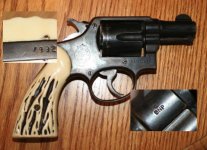- Joined
- Jun 10, 2009
- Messages
- 2
- Reaction score
- 0
I have a S&W, snub nose .38 with a serial number that starts with a prefix that has been partially worn off... It could be a Y, V, or W. I have attached a picture of the beginning of the number. There are 5 numbers total in addition to the mystery letter. Looks like this (I have omitted the last 2 numbers):
Mystery Letter 992xx.
I have also attached a few other pictures showing various other markings. One is a BNP Stamp on the barrel and cylinder. There appears to be a crown stamped with these markings. I've been told that this gun was produced by S&W for the Brits at the beginning of WWII and "BNP" stands for British Navy Pilot for use as a side arm if shot down.
Any insight on date or value would be great... Thanks
Mystery Letter 992xx.
I have also attached a few other pictures showing various other markings. One is a BNP Stamp on the barrel and cylinder. There appears to be a crown stamped with these markings. I've been told that this gun was produced by S&W for the Brits at the beginning of WWII and "BNP" stands for British Navy Pilot for use as a side arm if shot down.
Any insight on date or value would be great... Thanks


